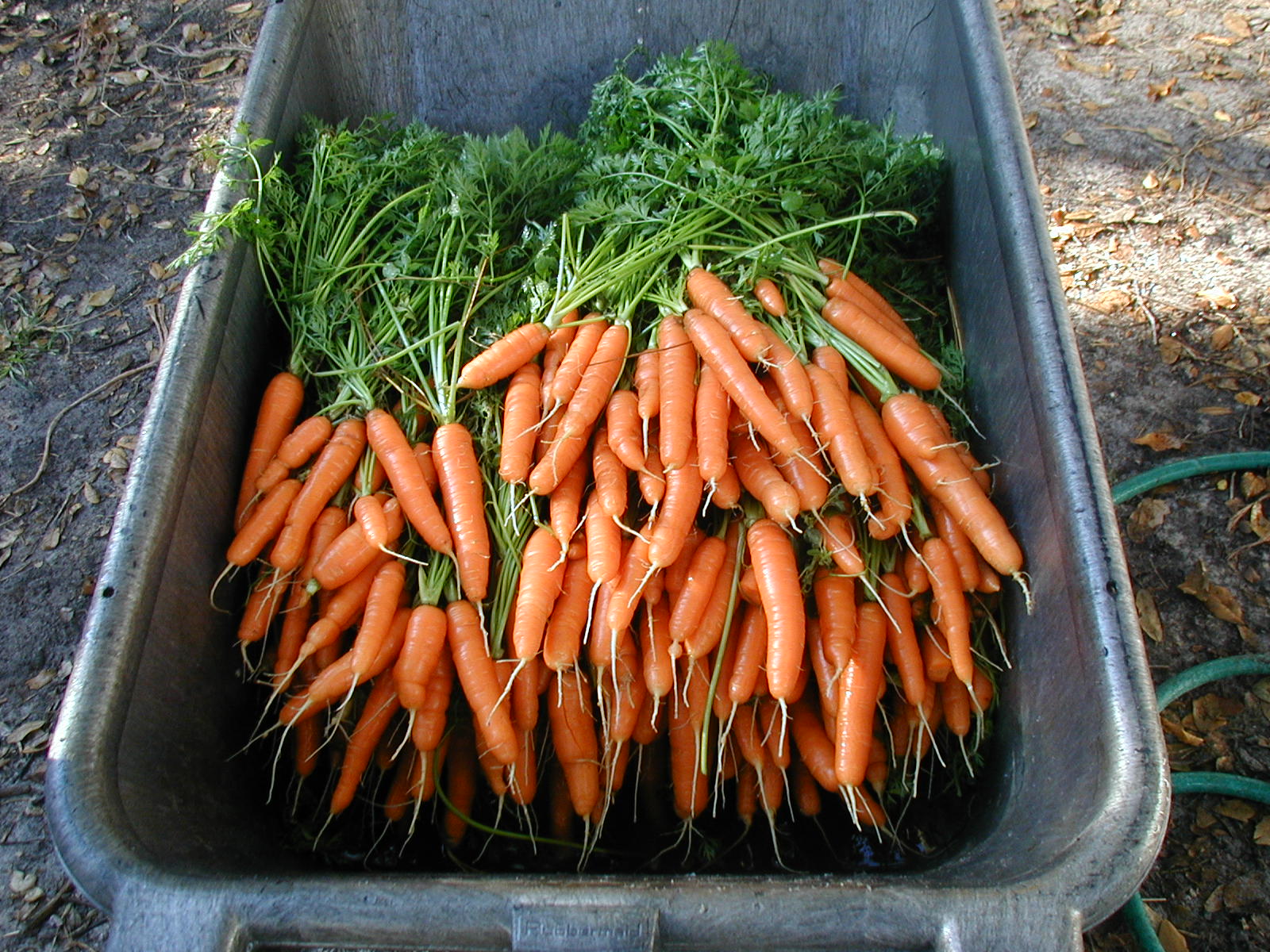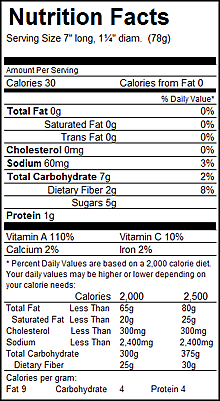Carrots

The carrot is a root vegetable, usually orange, purple, red, white, or yellow in color, with a crisp texture when fresh. The edible part of a carrot is a taproot. It is a biennial plant which grows a rosette of leaves in the spring and summer, while building up the stout taproot, which stores large amounts of sugars for the plant to flower in the second year.
As one of the most popular root vegetables in the U.S. – and widely enjoyed in many other countries as well – carrots almost feel like an old friend for many people who are looking for just the right crunchy snack or addition to a salad. We’ve even seen one study of 8-11 year-old children in France who were given pictures of 54 vegetables and were mostly likely to pick out carrots (along with lettuce and tomatoes) as easily identifiable and likeable vegetables. In the U.S., there seems to be an equal liking for carrots at the other end of the age spectrum as well. Individuals 76 years of age and older eat twice as many carrots as individuals under 40, with the overall average being about 1 cup of carrots per week.
It’s easiest to identify carrots as belonging to the Umbelliferae family of plants, since their leafy greens form an umbrella-like cluster at the top of the root. However, this same family of plants is also commonly known as the Apiaceae family. While the International Code of Botanical Nomenclature accepts both designations, the use of Apiaceae is becoming more and more common in carrot research. This same botanical family includes parsley, anise, celery, parsnips, fennel, caraway, cumin and dill.
The name “carrot” comes from the Greek word “karoton,” whose first three letters (kar) are used to designate anything with a horn-like shape. (That horn-like shape, of course, refers to the taproot of the carrot that is the plant part we’re most accustomed to consuming in the U.S.). The beta-carotene that is found in carrots was actually named for the carrot itself!
Even though U.S. consumers are most familiar with carrots as root vegetables bright orange in color, an amazing variety of colors are found worldwide for this vegetable. (All of these color varieties, however, still belong to the same genus and species of plant, Daucus carota.) Here is a short list of some of the more popular carrot varieties, categorized by color:
Orange Carrots
Scarlet Nantes (especially valued for its sweetness)
Danvers (often raised for processing)
Camden (often raised for processing)
Other popular varieties include Navajo, Sirkana, Top Cut and Inca
Purples Carrots
Indigo
Maroon
Purple Dragon
Cosmic Purple
Purple Haze
Yellow Carrots
Sunlite
Solar Yellow
Yellowstone
White Carrots
Creme De Lite
White Satin
Red Carrots
Supreme Chateney
Red Samurai
Sourced: http://www.whfoods.com/genpage.php?tname=foodspice&dbid=21
Storage
Short-Term Storage: Carrots can be stored in the refrigerator for up to a month if stored properly. Cut off carrot greens, place carrots in a containers with lid and cover completely in water. Keep container in the refrigerator, changing the water ever 4-5 days. Do not store carrots next to ethylene gas producing fruits, such as apples and pears. The ethylene gas they release speeds up the ripening process of other fruits and vegetables.
If you purchase carrot roots with attached green tops, the tops should be cut off before storing in the refrigerator since they will cause the carrots to wilt prematurely as they pull moisture from the roots. While the tops can be stored in the refrigerator, kept moist by being wrapped in a damp paper, they should really be used soon after purchase since they are fragile and will quickly begin to wilt.
Long-Term Storage: Carrots can also be stored unwashed and covered by sand. If stored in this manner in a dark, cool, well ventilated area, the carrots will last up to 5 or 6 months. They can also be left in the ground, covered with mulch, and used as needed until the ground begins to freeze. Carrots can also be peeled, cut up, blanched, and then frozen to preserve them for approximately a year.
Short-Term Storage: Carrots can be stored in the refrigerator for up to a month if stored properly. To prevent condensation from forming, wrap the carrots in a paper towel and then place them in a bag in the refrigerator, or use a perforated plastic bag. Excess moisture will cause them to rot. If the carrots still have the greens attached, cut them off 2 inches above the crown to prevent them from drawing moisture out of the carrots. Do not store carrots next to ethylene gas producing fruits, such as apples and pears. The ethylene gas they release speeds up the ripening process of other fruits and vegetables.
Long-Term Storage: Carrots can also be stored unwashed and covered by sand. If stored in this manner in a dark, cool, well ventilated area, the carrots will last up to 5 or 6 months. They can also be left in the ground, covered with mulch, and used as needed until the ground begins to freeze. Carrots can also be peeled, cut up, blanched, and then frozen to preserve them for approximately a year.
Carrot roots should be firm, smooth, relatively straight and bright in color. The deeper the orange-color, the more beta-carotene is present in the carrot. Avoid carrots that are excessively cracked or forked as well as those that are limp or rubbery. In addition, if the carrots do not have their tops attached, look at the stem end and ensure that it is not darkly colored as this is also a sign of age. If the green tops are attached, they should be brightly colored, feathery and not wilted. Since the sugars are concentrated in the carrots' core, generally those with larger diameters will have a larger core and therefore be sweeter.
Preparation & Cooking Tips
Wash carrots in cold water. Cut off the stem end and straggling roots if present. Peel older carrots or simply scrub or scrape young specimens.
Carrots can be eaten raw or cooked. Raw carrots are eaten as a snack, or an appetizer, and are sliced, chopped, or grated to add to salads. They can be cooked using many different methods, such as boiling, steaming, sautéing, roasting or grilling. When cooked, carrots are eaten as a side dish on their own or cooked with other vegetables. They are also often added to other dishes, such as stir fries, casseroles, quiches, omelets, soups, and stews. The sweet flavor of carrots also makes them a popular ingredient in baking cakes, muffins, breads, and cookies.
Tips for Preparing Carrots
Wash carrot roots and gently scrub them with a vegetable brush right before eating. Unless the carrots are old, thick or not grown organically, it is not necessary to peel them. If they are not organically grown, peel them; most all conventionally grown carrots are grown using pesticides and other chemicals. If the stem end is green, it should be cut away as it will be bitter. Depending upon the recipe or your personal preference, carrots can be left whole or julienned, grated, shredded or sliced into sticks or rounds.
Carrots are delicious eaten raw or cooked. While heating can often damage some of the delicate phytonutrients in vegetables, the beta-carotene as found in carrots has been shown to be surprisingly heat-stable. In fact, carrots' beta-carotene may become more bioavailable through well-timed steaming. Still, be careful not to overcook carrots if you want to your carrots to retain their maximum flavor and strong overall nutritional value.
The Healthiest Way of Cooking Carrots
Of all of the cooking methods we tried when cooking carrots, our favorite is Healthy Steaming. We think that it provides the greatest flavor and is also a method that allows for concentrated nutrient retention. In fact, participants in a recent research study agreed with us. When study participants were asked to evaluate the flavor and overall acceptability of different carrot cooking methods, they significantly favored the flavor and overall acceptability of steamed carrots to boiled carrots. This preference was even expressed by participants who had always boiled carrots in their previous kitchen practices!
To Healthy Steamed carrots, fill the bottom of the steamer with 2 inches of water and bring to a rapid boil. Slice carrots ¼-inch thick and steam for 5 minutes. Transfer to a bowl. For more flavor, toss carrots with our Mediterranean Dressing. (Looking for carrots with extra zing? Try our Carrots with Honey Mustard Sauce recipe.)
How to Enjoy
A Few Quick Serving Ideas
Shredded raw carrots and chopped carrot greens make great additions to salads.
Combine shredded carrots, beets and apples, and eat as a salad.
For quick, nutritious soup that can be served hot or cold, purée boiled carrots and potatoes in a blender or food processor, and add herbs and spices to taste.
Spiced carrot sticks are a flavorful variation on an old favorite at parties or at the dinner table. Soak carrot sticks in hot water spiced with cayenne, coriander seeds and salt. Allow to cool, drain and serve.
Nutrition
The following nutrition information is for one raw carrot (78 grams).
Source: Fruitsandveggiesmorematters.com
Carrots are perhaps best known for their beta-carotene content. (The nutrient beta-carotene was actually named after the carrot!) While they can be an outstanding source of this phytonutrient, carrots actually contain a fascinating combination of phytonutrients, including other carotenoids (especially alpha-carotene and lutein); hydroxycinnamic acids (including caffeic, coumaric, ferulic); anthocyanins (in the case of purple and red carrots); and polyacetylenes (especially falcarinol and falcarindiol). Carrots are an excellent source of vitamin A (in the form of carotenoids). In addition, they are a very good source of biotin, vitamin K, dietary fiber, molybdenum, potassium, vitamin B6, and vitamin C. They are a good source of manganese, niacin, vitamin B1, panthothenic acid, phosphorus, folate, copper, vitamin E, and vitamin B2.

